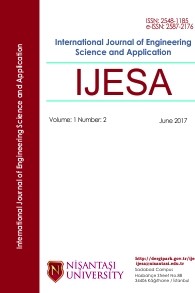Thermal design and modeling of a steam reformer for solid oxide fuel cell fed by natural gas
Thermal design and modeling of a steam reformer for solid oxide fuel cell fed by natural gas
COMSOL Multiphysics, Fuel cell, , Hydrogen, Natural gas Steam reforming,
___
- [1] Erdener H, Erkan S, Eroğlu E, Gür N, Şengül E, Baç N, 2007. Sürdürülebilir Enerji ve Hidrojen, ODTÜ Yayıncılık, Ankara, p.105 (in Turkish)
- [2] Siddle A, Pointon KD, Judd RW, 2003. Jones SL, Fuel Processing for Fuel Cells – Status Review and Assessment of Prospects, A report of Advantica Ltd, ETSU F/03/00252/REP. URN 031644 p.124
- [3] Froment GF, Bischoff KB, 2010. Chemical Reactor Analysis and Design, John Wiley and Sons, Canada, p664
- [4] Ding Y, Alpay E, 2000. Adsorption-enhanced steam methane reforming. Chem Eng. Sci. 55:3929- 3940
- [5] Zamaniyan A, Zoghi AT, Ebrahimi H, 2008. Software development for design and simulation of terraced wall and top fired primary steam reformers. Comput. Chem. Eng. 32:1433-1446
- [6] Zanfir M, Gavriilidis A, 2003. Catalytic combustion assisted methane steam reforming in a catalytic plate reactor. Chem. Eng. Sci. 58: 3947- 3960
- [7] Wilke CH, 1950. A viscosity equation for gas mixtures. J. Chem. Phys. 18: 517- 519
- [8] Chung TH, Lee LL, Starling KE, 1984. Applications of kinetic gas theories and multiparameter correlation for prediction of dilute gas viscosity and thermal conductivity. Ind. Eng. Chem. Fund. 23: 8-13
- [9] Chung TH, Ajlan M, Lee LL, Starling KE, 1988. Generalized multiparameter correlation for nonpolar and polar fluid transport properties, Ind. Eng. Chem. Res. 27: 671- 679
- [10] Poling BE, Prausnitz JM, O’Connell JP, 2007. The Properties of Gases and Liquids, McGraw ill, Singapore, p.768
- [11] Wassiljewa A, 1904. Heat conduction in gas mixtures. Physik. Z. 5: 737 – 742
- [12] Mason EA, Saxena SC, 1958. Approximate formulae for the thermal conductivity of gas mixtures. Phys. Fluid 1: 361 – 369
- [13] Yaws CL, 1999. Chemical Properties Handbook, McGraw Hill, New York, p780
- [14] Blanc, MA, 1908. Recherches sur les mobilites des ions dans les gaz. J. Phys. 7: 825 – 839
- [15] Fuller EN, Giddings JC, 1965. A comparison of methods for predicting gaseous diffusion coefficients. J. Chromatogr. Sci. 3: 222- 227
- [16] Fuller EN, Schettler PD, Giddings JC, 1966. New method for prediction of binary gas-phase diffusion coefficients. Ind. Eng. Chem. 58: 18- 27
- [17] Fuller EN, Ensley K, Giddings JC, 1969. Diffusion of halogenated hydrocarbons in helium. The effect of structure on collision cross sections. J. Phys. Hem. 73: 3679-3685
- [18] Hoang, D.L., Chan, S.H., and Ding, O.I., 2005, Kinetic and modelling study of methane steam reforming over sulfide nickel catalyst on a gamma alumina support, Chemical Engineering Journal, 112:1–11.
- ISSN: 2548-1185
- Başlangıç: 2016
- Yayıncı: Nişantaşı Üniversitesi
Thermal design and modeling of a steam reformer for solid oxide fuel cell fed by natural gas
DEFINING THE PROBLEMS OF INTEGRATED ALGAE PHOTOBIOREACTOR SYSTEMS TO ARCHITECTURE
Funda ÖZTÜRK KERESTECİOĞLU, Yunus Turan PEKMEZCİ
Tina Francis-Akilaki, Monday Omoregie
Development of Shredding and Washing Machine for Polyethylene Terephthalate (PET) Bottles Pelletizer
